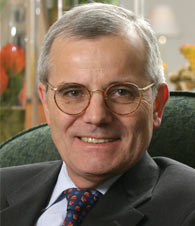|
Executive Interviews: Interview with Dr. Bolko V Oetinger on Business Model Innovation
April 2009
-
By Dr. Nagendra V Chowdary
What is polycentrism and how can
this be a source of competitive
advantage? Your business might have an obvious
center and a far distant periphery, but
it also might be organized like a
network of many “centers” (research
centers, competence centers, supplier networks), where many places of
equal importance need to be
coordinated. This is an analog to a
federation of cities, where different
cities were specializing around
different craftsmanship or industries. I
use the word “center” as
representative of a place shaped by
strong beliefs about its own success.
The strong belief structure makes
innovation so hard. If you have a
company with many such centers,
there is a higher chance that newideas
might enter, because the walls are
usually not so high across the centers
and the inhabitants of these centers
know that there are many other
options around, so the mindset is
more open. However, each center will
struggle with its own belief structure. Does the ‘center and periphery’
perspective apply to British
manufacturing’s competitiveness,
where Britain lost its competitive edge
in industry after industry— first it
was textile industry, then it was the
turn of movie industry, then
motorcycle industry (remember, the
famous BCG report commissioned in
1975), automobile industry, financial
services industry, etc.? I would not trace back the loss of
competitiveness of entire industries
in a country to a single dimension.
Take the British car industry, it had
never gained any real significant
stronghold outside Britain and just
missed global competitiveness.
When TATA finally picked up
Jaguar and Landrover, it was not by
attacking the British market from the
periphery, rather rescuing the two
companies. The center/periphery
analogy works best, I believe, in
explaining disruptive innovations
which by definition means applying
an outside method/approach/
technology to a different (distant)
business (software to music). Please
observe, using words like “outside”, “periphery”, “distant”, I have been
back to the spatial world. You have observed that, “as the
history of great innovators such as
Apple, Google, and Microsoft
demonstrates a business might begin
at the periphery and, as it increasingly
enjoys success, end up at the center.
Then, once it occupies the center, it
will soon face new competitors at its
periphery.” Therefore how should
‘center’ players guard their market
positions against the imminent
‘periphery’ threats? It’s definitely a
never-ending game. You are (fortunately!) right,
innovative businesses are a neverending
game. Your competitive
advantage is only valid as long as
nobody else is able to erode your
margins and your share. All
businesses start lean, small, flexible
and entrepreneurial. On maturing
they gain share, get larger and larger to
become complex, fat, change-resistant
and often dominated by managers
instead of entrepreneurs. This
cultural metamorphosis is not due to
bad will or neglect. The more
successful you are the more you must
believe that you do the most things
right (actually you do) and you
believe (here starts the evil) that you
can rely on just continuing your
successful path. You lose the critical
reflection. Your success becomes
your biggest enemy from inside. As
managers we get paid for delivering
success, so we look (rightly) for
sources of success, but,
unfortunately, we often ignore the
consequences of our own success. What according to you is a
business model (with elaborate and
differing definitions apart)? What do
you think are its critical components? A business model is a company’s
unique value architecture creating
customer value and sustainable
competitive advantage as the
foundation of lasting financial
success. Is there any difference between a
business model and a business plan?
Few mistakenly suggest that for
entrepreneurship courses, it is
business plan and for strategy course
it is business model. Surely the truth
is something else? Can you elaborate
on the differences between a business
model and a business plan? The business model is the
architectural design; the business
plan is the development or the
creation of a market for that business
model over time.
|
